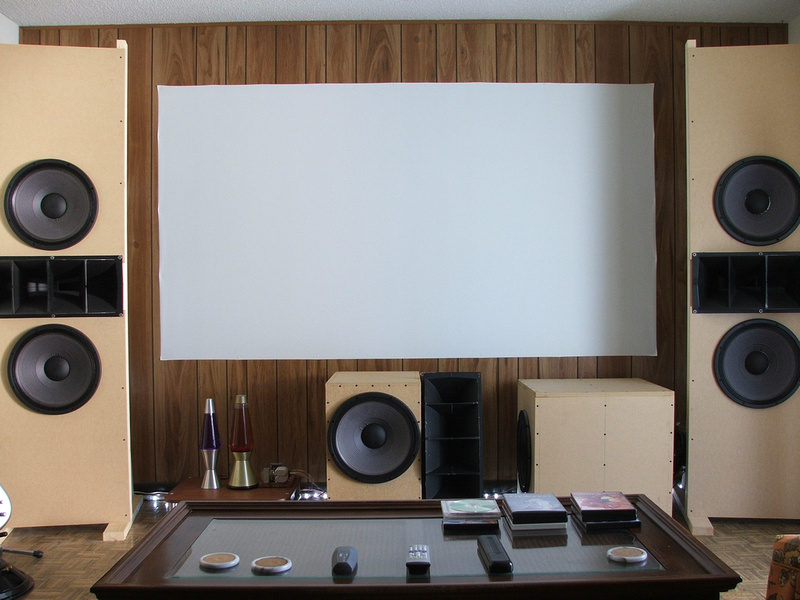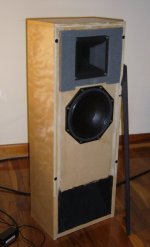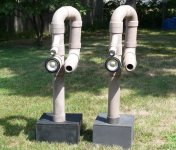I think a crossover point around 1500 Hz is eminently feasible with such a tweeter, especially one with a narrow front plate, provided the middle-aged or older listener does not care much for top octave extension he can not hear anyway. Wavelength at 1500 Hz is around 23 cm or 9 inches, just enough to squeak an 8" through.
I crossed a DE250/ME20 horn over to an 8" woofer @ 1600 Hz, second order LR. It sounds ok to me.
Attachments
. While any self-respecting speaker company would not sell a speaker expressly "made for old geezers"(a more politically correct term may be substituted) a DIYer need not be thus constrained. A shallower profile tweeter, albeit one with narrower dispersion, may ameliorate top octave response droop on axis, and inverted (concave rather than convex, as practiced by Focal and Accuton) profiles may also help here.
I think a crossover point around 1500 Hz is eminently feasible with such a tweeter, especially one with a narrow front plate, provided the middle-aged or older listener does not care much for top octave extension he can not hear anyway. Wavelength at 1500 Hz is around 23 cm or 9 inches, just enough to squeak an 8" through.
Troels Gravesen has done some excellent (as usual) work on larger tweeters. Any practical experience? Salas, do you think that a larger tweeter can make the Tired2Way a ReTired2Way ("retired person's two way")?!?
Hi bbggg,
Linkwitz Pluto uses a 2 inch fullrange driver as a tweeter (inverted titanium diaphragm), albeit in an active configuration, actively equalized with additional gain. The drive unit is crossed to the mid bass at 1khz. Chosen for broad dispersion (no faceplate) and extremely low crossover potential to enable omni dispersion.
The results are surprisingly superb, even if you are used to the likes of top flight tweeters such as the Heil motion Transformer, top end soft/hard domes you will not feel short changed. No significant nasties, splash, fizzy breakup, harshness or grain.
For me this tells me that the low and mid treble is much more important than the highest frequencies which have virtually nothing to do with music. The key is in the smooth driver integration and low distortion where it really counts, where there is significant energy in the music.
However Pluto's tweeter is a whopping 84db/1w and requires equalization, so hardly suitable for integration in a passive design but should be fine with an 8 inch or 10 inch in an active configuration.
I'm no octogenarian or deaf old rocker either, I can still hear clearly up to the 18khz test tones, if I wack up the volume (a lot) I can just about hear above this fwiw.
listening to test tones over 12khz shows these frequencies have nothing significant to tell us about the music or room acoustics. Just increasingly unpleasant ever higher pitch drones.
Last edited:
Not mounting drive units in tubes is generally good advice but if you hear the active Linkwitz Pluto's set up properly you will know that this is most definately not always a bad idea, in the right hands.
Note Pluto's tubes are very heavily stuffed and the speaker is actively equalized. Yet the speaker is fast (for want of a better word) immediate and open.
If for instance you like the seamless natural delivery of sound and boxless presentation of the best Electrostatics and magneplanars I am confident in saying completely regardless of budget and whatever speakers you have heard and owned you will know pretty quickly that you are listening to one of the best small-medium size loudspeakers you have ever heard.
That's with plastic tubes and ply and (in my case) a tiny amount of mdf.
Here's a pic of a project I build I call the "Poor Plumber's Pluto". It utilizes the same drivers used in ZL's Pluto in a TL design with 4 inch ABS pipe and the inclusion of a powered sub woofer in the base of one of them. I have polars comparing my passive xover PPP's to ZL's I'd be glad to share if you want to PM me. I'd post them but they include ZL's copyrighted polars. My project cost about 10% of what his retails for.
Attachments
Here's a pic of a project I build I call the "Poor Plumber's Pluto". It utilizes the same drivers used in ZL's Pluto in a TL design with 4 inch ABS pipe and the inclusion of a powered sub woofer in the base of one of them. I have polars comparing my passive xover PPP's to ZL's I'd be glad to share if you want to PM me. I'd post them but they include ZL's copyrighted polars. My project cost about 10% of what his retails for.
Okay, I'm starting to sound like a broken record, but the Pluto's do not!
I think a crossover point around 1500 Hz is eminently feasible with such a tweeter, especially one with a narrow front plate, provided the middle-aged or older listener does not care much for top octave extension he can not hear anyway. Wavelength at 1500 Hz is around 23 cm or 9 inches, just enough to squeak an 8" through.
I crossed a DE250/ME20 horn over to an 8" woofer @ 1600 Hz, second order LR. It sounds ok to me.
8 inchers are about 16cm active diameter, the 23cm assumption is ample.
Okay, I'm starting to sound like a broken record, but the Pluto's do not!
Huh? do not what?
The thing about horns and waveguides is that distance between drivers increases, which can be kind of self defeating unless one crosses quite low, eg 1 kHz or lower, which is in the compression driver ballpark. My point was WRT conventional direct radiator drivers. Just thinking about it intuitively, a shallow profile 32 to 34 mm dome should hit the sweet spot. I got the idea a few years ago when reading that 1400 Hz is just about the high limit of coloratura singing, so I thought, in a leap of faith sort of way, that voice fundamentals should stay on one side of a two way crossover.
Back to head line, I think 2-way speaker could be very fine if price and size are not limiting. For example Usher D2 is two speaker.
The Usher D2... I was in the middle of making the D2 clones until I tried running the Usher 15HM drivers on open baffles to break them in. What I heard (without EQ) was amazing, so I decided to do a D2 clone but in OB fashion.
It was an active 2-way using two Usher 15HM drivers, an Altec 511B horn and Altec 902-8B drivers. Efficient at around 99dB @ 1w/1m and was capable of reaching down to 20Hz as well as getting quite loud while remaining smooth and clean. They also imaged quite well since there was very little side wall interaction due to the directivity of the horns and the OB emitting very little sound off to the sides. I only used the sub for movies.
I miss those speakers, but they were huge and rather ugly...



The thing about horns and waveguides is that distance between drivers increases, which can be kind of self defeating unless one crosses quite low, eg 1 kHz or lower, which is in the compression driver ballpark. My point was WRT conventional direct radiator drivers. Just thinking about it intuitively, a shallow profile 32 to 34 mm dome should hit the sweet spot. I got the idea a few years ago when reading that 1400 Hz is just about the high limit of coloratura singing, so I thought, in a leap of faith sort of way, that voice fundamentals should stay on one side of a two way crossover.
I'm not sure the practice of putting the acoustic centers closer together than the wavelength of sound at the crossover frequency applies to horns. It could, I just don't know for sure.
Troels has done some experiments look at Part II and III and came up with these designs TQWT and QUATTRO
He wants high sensitivity but he doesn't look to professional drivers?

Huh? do not what?
yeah that confused me too, but i think he means that they don't sound like a broken record like he perceives he does
rob g said:Okay, I'm starting to sound like a broken record, but the Pluto's do not!
Troels has done some experiments look at Part II and III and came up with these designs TQWT and QUATTRO
Those designs are built around a high-efficiency driver, the custom Seas model. You can get quite similar drivers also from Audio Note UK. Anyway, for a good 2-way all you need is a waveguide (Monacor waveguide or similar, Dayton 8" which is bigger, or P-Audio PCT-300 https://www.intertechnik.de/Shop/La...er/_71503_H185-PCT-300HORN_1768,de,3726,53087 , the MCM H-65 doesn't seem to be available anymore) - large enough to reach the lowish crossover point which minimizes the cone break distortion on the woofer and mathced the directivity of the drivers - an 8 inch woofer, like CA22RNY, and a low fs tweeter (ring radiators like XT25 seem to avoid phase problems at >10k).
Last edited:
yeah that confused me too, but i think he means that they don't sound like a broken record like he perceives he does
Yes this is what I meant, sorry for the confusion.
How about Seas A26RE4 and Seas 27TDFC in a 35L sealed enclosure? Would that sound any good?
A26RE4 can produce very good results.
If you have been used to relatively clean balanced smooth uncoloured reproduction at any time then do not run this driver fullrange. Running this fullrange is just wishful thinking. This 10 incher cannot walk on water.
A26RE4 can produce very good results.
If you have been used to relatively clean balanced smooth uncoloured reproduction at any time then do not run this driver fullrange. Running this fullrange is just wishful thinking. This 10 incher cannot walk on water.
I am actually planning on using this speaker on a portable suitcase, like a boombox. Going mono. I dont mind any coloration on the sound as I will be playin music like dubstep and etc most of the time! I am just curious about how it would perform in a 35-45L suitcase. Will it be able to produce any bass? What about sound quality? I also read somewhere that it can be used without a XO, that would save me some money if so!
The "Running this" part is superfluous.Running this fullrange is just wishful thinking
- Status
- This old topic is closed. If you want to reopen this topic, contact a moderator using the "Report Post" button.
- Home
- Loudspeakers
- Multi-Way
- The secret of building a good 2-way

